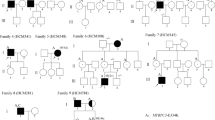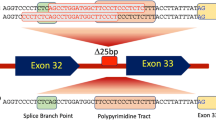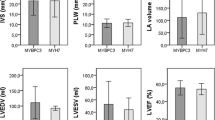Abstract
Hypertrophic cardiomyopathy (HCM) is a frequent, autosomal-dominant cardiac disease and manifests predominantly as left ventricular hypertrophy. Mutations in the cardiac beta-myosin heavy chain gene (MYH7) are responsible for the disease in about 30% of cases where mutations were identified. We clinically evaluated a large group of 147 consecutive HCM patients from three cardiology centers in Germany, Poland, and Kyrgyzstan according to the same protocol. The DNA of the patients was systematically analyzed in the whole coding region of the MYH7 gene using PCR, single-strand conformation polymorphism analysis, and automated sequencing. Eleven different missense mutations (including seven novel ones) in 11 unrelated patients were identified, showing a mutation frequency of 7.5% in the study population. We further examined the families of five patients (three of German, one of Polish, and one of Kyrgyz origin) with 32 individuals in total. We observed a clear, age-dependent penetrance with onset of disease symptoms in the fourth decade of life. Genotype–phenotype correlations were different for each mutation, whereas the majority was associated with an intermediate/malign phenotype. In conclusion, we report a systematic molecular screening of the complete MYH7 gene in a large group of consecutive HCM patients, leading to a genetic diagnosis in 38 individuals. Information about the genotype in an individual from one family could be very useful for the clinician, especially when dealing with healthy relatives in doubt of their risk about developing HCM. The increasing application of genetic screening and the increasing knowledge about genotype–phenotype correlations will hopefully lead to an improved clinical management of HCM patients.



Similar content being viewed by others
References
Ciro E (1983) Heterogeneous morphologic expression of genetically transmitted hypertrophic cardiomyopathy: two-dimensional echocardiographic analysis. Circulation 67:1227–1233
Maron BJ, Bonow RO, Seshagiri TNR, Roberts WC, Epstein SE (1981) Hypertrophic cardiomyopathy with ventricular septal hypertrophy localized to the apical region of the left ventricle. Am J Cardiol 49:1838–1848
Roberts R, Sigwart U (2001) New concepts in hypertrophic cardiomyopathy, part I. Circulation 104:2113–2116
Maron BJ (2002) Hypertrophic cardiomyopathy: a systematic review. JAMA 287:1308–1320
Seidman JG, Seidman C (2001) The genetic basis for cardiomyopathy: from mutation identification to mechanistic paradigms. Cell 104:557–567
Marian AJ, Roberts R (2001) The molecular genetic basis for hypertrophic cardiomyopathy. J Mol Cell Cardiol 33:655–670
Jaenicke T, Diederich KW, Haas W, Schleich J, Lichter P, Pfordt M, Bach A, Vosberg HP (1990) The complete sequence of the human b-myosin heavy chain gene and a comparative analysis of its product. Genomics 8:194–206
Ackerman MJ, Van Driest SL, Ommen SR, Will ML, Nishimura RA, Tajik AJ, Gersh BJ (2002) Prevalence and age-dependence of malignant mutations in the beta-myosin heavy chain and troponin t genes in hypertrophic cardiomyopathy. J Am Coll Cardiol 39:2042–2048
Richardson P, McKenna W, Bristow M, Maisch B, Mautner B, O’Connel J, Olsen EGJ, Thiene G, Guyarfas I (1996) Report of the 1995 WHO/ISFC Task Force on the definition and classification of cardiomyopathies. Circulation 93:841–842
McKenna WJ, Spirito P, Desnos M, Dubourg O, Komajda M (1997) Experience from clinical genetics in hypertrophic cardiomyopathy: proposal for new diagnostic criteria in adult members of affected families. Heart 77:130–132
Sahn DJ, DeMaria A, Kisslo J, Weyman A (1978) The Committee on M-mode standardization of the American Society of Echocardiography: recommendations regarding quantitation in M-mode echocardiography: results of a survey of echocardiographic measurements. Circulation 58:1072–1083
Lahiri DK, Nurnberger JI (1991) A rapid non-enzymatic method for the preparation of HMW DNA from blood for RFLP studies. Nucleic Acids Res 19:5444
Jääskeläinen P, Soranta M, Miettinen R, Saarinen L, Pihlajamäki J, Silvennoinen K, Tikanoja T, Laakso M, Kuusisto J (1998) The cardiac beta-myosin heavy chain gene is not the predominant gene for hypertrophic cardiomyopathy in the Finnish population. J Am Coll Cardiol 32:1709–1716
Mörner S, Richard P, Kazzam E, Hellman U, Hainque B, Schwartz K, Waldenström A (2003) Identification of the genotypes causing hypertrophic cardiomyopathy in northern Sweden. J Mol Cell Cardiol 35:841–849
Richard P, Charron P, Carrier L, Ledeuil C, Cheav T, Pichreau C, Benaiche A, Isnard R, Dubourg O, Burban M, Gueffet JP, Millaire A, Desnos M, Schwartz K, Hainque B, Komajda M (2003) Hypertrophic cardiomyopathy—distribution of disease genes, spectrum of mutations, and implications for a molecular diagnosis strategy. Circulation 107:2227–2232
Van Driest SL, Jaeger MA, Ommen SR, Will ML, Gersh BJ, Tajik AJ, Ackerman MJ (2004) Comprehensive analysis of the beta-myosin heavy chain gene in 389 unrelated patients with hypertrophic cardiomyopathy. J Am Coll Cardiol 44:602–610
Erdmann J, Daehmlow S, Wischke S, Senyuwa M, Werner U, Raible J, Tanis N, Dyachenko S, Hummel M, Hetzer R, Regitz-Zagrosek V (2003) Mutation spectrum in a large cohort of unrelated consecutive patients with hypertrophic cardiomyopathy. Clin Genet 64:339–349
Hougs L, Havndrup O, Bundgaard H, Kober L, Vuust J, Larsen LA, Christiansen M, Andersen PS (2005) One third of Danish hypertrophic cardiomyopathy patients have mutations in MYH7 rod region. Eur J Hum Genet 13:161–165
Hoffmann B, Schmidt-Traub H, Perrot A, Osterziel KJ, Geßner R (2001) First mutation in cardiac troponin C, L29Q, in a patient with hypertrophic cardiomyopathy. Human Mutat 17:524
Geier C, Perrot A, Özcelik C, Binner P, Counsell D, Hoffmann K, Pilz B, Martiniak Y, Gehmlich K, van der Ven PFM, Fürst DO, Vornwald A, von Hodenberg E, Nürnberg P, Scheffold T, Dietz R, Osterziel KJ (2003) Mutations in the human muscle LIM protein gene in families with hypertrophic cardiomyopathy. Circulation 107:1390–1395
Vidal-Puig A, Moller DE (1994) Comparative sensitivity of alternative single-strand conformation polymorphism (SSCP) methods. Biotechniques 17:490–496
Jordanova A, Kalaydjieva L, Savov A, Claustres M, Schwarz M, Estivill X, Angelicheva D, Haworth A, Casals T, Kremensky I (1997) SSCP analysis: a blind sensitivity trail. Human Mutat 10:65–70
Fananapazir L, Dalakas MC, Cyran F, Cohn G, Epstein ND (1993) Missense mutations in the beta-myosin heavy chain gene cause central core disease in hypertrophic cardiomyopathy. Proc Natl Acad Sci USA 90:3993–3997
Woo A, Rakowski H, Liew JC, Zhao MS, Liew CC, Parker TG, Zeller M, Wigle ED, Sole MJ (2003) Mutations of the beta myosin heavy chain gene in hypertrophic cardiomyopathy: critical functional sites determine prognosis. Heart 89:1179–1185
Niimura H, Bachinski LL, Sangwatanaroj S, Watkins H, Chudley AE, McKenna W, Kristinsson A, Roberts R, Sole M, Maron BJ, Seidman JG, Seidman CE (1998) Mutations in the gene for cardiac myosin-binding protein C and late-onset familial hypertrophic cardiomyopathy. N Engl J Med 338:1248–1257
Arad M, Seidman JG, Seidman CE (2002) Phenotypic diversity in hypertrophic cardiomyopathy. Hum Mol Genet 11:2499–2506
Blair E, Redwood C, Oliveira M, Moolman-Smook JC, Brink P, Corfield VA, Östman-Smith I, Watkins H (2002) Mutations in the light meromyosin domain of the beta-myosin heavy chain rod in hypertrophic cardiomyopathy. Circ Res 90:263–269
Lowey S (2002) Functional consequences of mutations in the myosin heavy chain at sites implicated in familial hypertrophic cardiomyopathy. Trends Cardiovasc Med 12:348–354
Acknowledgements
The authors declare that there are no conflicts of interest. We thank the families for their cooperation in this study. Further, we thank all of our colleagues in the three hospitals for invaluable help in the recruitment of patients. Especially, we thank U. Weiher and A. Köstner for excellent technical assistance. This study was supported by a grant-in-aid from Charité-Universitätsmedizin, Berlin.
Author information
Authors and Affiliations
Corresponding author
Additional information
An erratum to this article can be found at http://dx.doi.org/10.1007/s00109-005-0722-9
Andreas Perrot and Hajo Schmidt-Traub contributed equally to this work
Rights and permissions
About this article
Cite this article
Perrot, A., Schmidt-Traub, H., Hoffmann, B. et al. Prevalence of cardiac beta-myosin heavy chain gene mutations in patients with hypertrophic cardiomyopathy. J Mol Med 83, 468–477 (2005). https://doi.org/10.1007/s00109-005-0635-7
Received:
Accepted:
Published:
Issue Date:
DOI: https://doi.org/10.1007/s00109-005-0635-7




